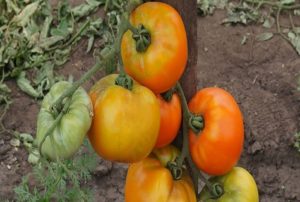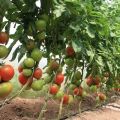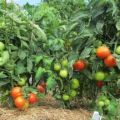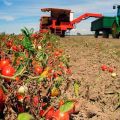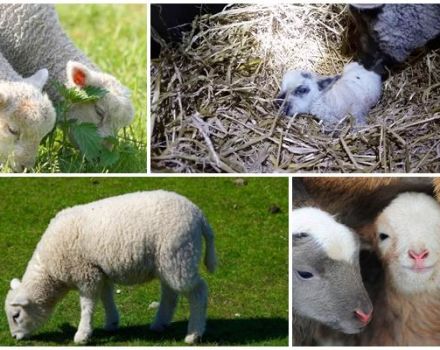Characteristics and description of the Negritenok tomato variety, its yield
The variety "Negritenok" belongs to the category black-fruited tomatoes... But the description characterizes its fruits as brown rather than black.
Exotic tomatoes are grown according to the same rules as ordinary varieties. Observing simple recommendations, you can diversify the harvest of tomatoes of traditional colors with chocolate-colored tomatoes.
Tomato characteristic
Fruit color is a varietal feature, but Negritok tomatoes acquire a characteristic chocolate shade only when they reach full ripeness. Therefore, you need to make some effort so that the indeterminate bush has time to lay the fruits in time. This is the characteristic of the variety by its manufacturer:
- the variety "Negritenok" is mid-season, the fruits ripen 110-115 days after the first shoots;
- the tomato is recommended for growing without shelter and in spring-type greenhouses without heating;
- the advantages of the variety include resistance to a number of diseases: to alternaria leaf spot, cladosporium disease, tobacco mosaic virus;
- plant of indeterminate type, with unlimited growth. During the growing season, it grows up to 1.5-2 meters;
- requires a garter, timely removal of side shoots, the formation of a bush;
- ordinary leaves, corrugated, dark green;
- the first inflorescence is formed above the level of 9-12 leaves, further brushes - after 3 leaves;
- at a planting density of 3-4 plants per square meter, the yield is not very high; is about 6.5 kg;
- fruits are formed weighing up to 100-160 g;
- the shape of the tomatoes is flat-round, with a slight ribbing at the base;
- mature fruits are brown with a red tint;
- the pulp is quite dense, soft and very juicy. Tomatoes with a pronounced tomato flavor, sweet with a slight sourness, aromatic;
- used as salad dressings and for making juices, tomato pastes, soups;
- the fruits harvested in green form are well ripened at home and retain their consumer qualities for up to 1.5 months.
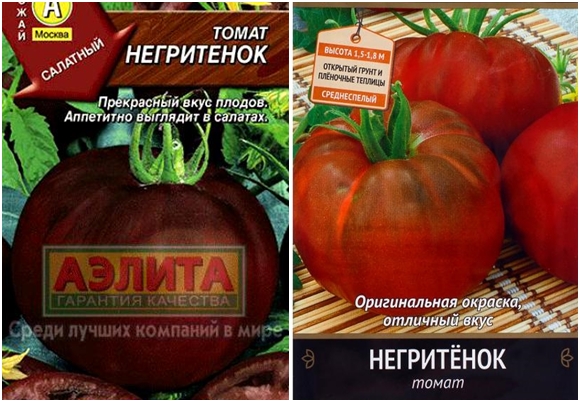
All who planted this variety unanimously note the very pleasant, refreshing taste of the fruit. These advantages are indicated by the reviews of most gardeners, who argue that even with such an average yield, it is worthwhile to allocate a place for the "Negro".
Low seedlings are planted vertically, 2-3 cm deeper than they grew. Elongated seedlings are planted at an angle with the tip to the south, southeast, covering the stem with earth. With this planting, additional roots are formed, and leafy stems are less affected by the sun.
Growing and caring for exotic tomatoes
Considering the varietal characteristics, the necessary measures should be taken to grow strong and healthy seedlings, which will be the key to the future harvest.
Growing seedlings
Prepare the soil mixture in advance. The substrate must be moisture-consuming, breathable, free of pathogens. The earth is heated at 80-90 degrees, adding complex fertilizers to the mixture.
- Seeds begin to be planted on seedlings 60-65 days before transplanting into a greenhouse or open ground.
- They are prepared according to traditional rules, treated with a weak manganese solution and kept in a growth stimulant.
- For growing in a greenhouse, seeds are planted for seedlings in the first half of March, and for open ground in the second decade of March.
- It is important for seedlings to create a balance between temperature and light intensity. Germinate seeds at 23-25 degrees. Later, with the appearance of the first shoots, the temperature is reduced to 12-15 degrees in the daytime and 8-10 degrees at night.
- Seedlings dive at the age of 2 permanent leaves into separate containers. From this point on, care consists of top dressing, moderate watering, and loosening the soil.
- Moderate watering, top dressing every 2-3 weeks. The composition of the fertilizer is selected individually, depending on the condition of the seedlings.
Seedlings of an indeterminate variety are prone to "stretching". You can prevent this trouble by adjusting the air temperature. At night, it should drop to 10-12 degrees. In intense sunlight, maintain at 20-25 degrees, in cloudy weather 15-18 degrees.
During the flowering period, non-root feeding with boric acid is carried out. Spraying has the same effect as treating tomatoes with a growth stimulant. The solution consists of a liter of water and 1 gram of boric acid dissolved in it. Top dressing is carried out in the evening.
Planting plants in a permanent place
Seedlings are planted in a greenhouse in the second decade of May, and in open ground from mid-May to early June.
- Planting scheme 60 x 40, or 3-4 bushes per square meter of area. Planting density depends on how many stems you plan to form the plant.
- If the bush will be formed into one stem, then 4 bushes can be planted per square meter, if in 2 stems, then the feeding area needs to be increased. Plant no more than 3 plants per square meter.
- After the seedlings have taken root, top dressing is carried out and the stem is tied to a support.
- Further care of Negrityat seedlings is reduced to weeding, watering, loosening the soil, removing stepchildren and dying foliage from the lower part of the stem.
- Tomatoes are grown in one or two stems. The reserve shoot is formed from the stepson under the very first brush. All lower leaves are recommended to be removed.
- The stepsons are pruned regularly, preventing the shoots from overgrowing and thereby pulling off food.
- 3-4 weeks before the last harvesting, pinch the top point of the plant, leaving 3-4 leaves above the last brush.
- The indents are distinguished by the gradual ripening of the fruits. The plant forms the largest and earliest fruits on two lower clusters.
- The variety is resistant to the most common diseases and is not a hassle in this regard. In the opinion of an experienced gardener who grew "Negritenka" in a film greenhouse, only he endured the vagaries of the weather without getting sick.
- The rest of the care is standard, moderate watering, root dressing, soil loosening. All this has long become the norm and is relevant for tomatoes of any kind.

It is worth planting a "chocolate" tomato and objectively assessing its advantages and disadvantages.

